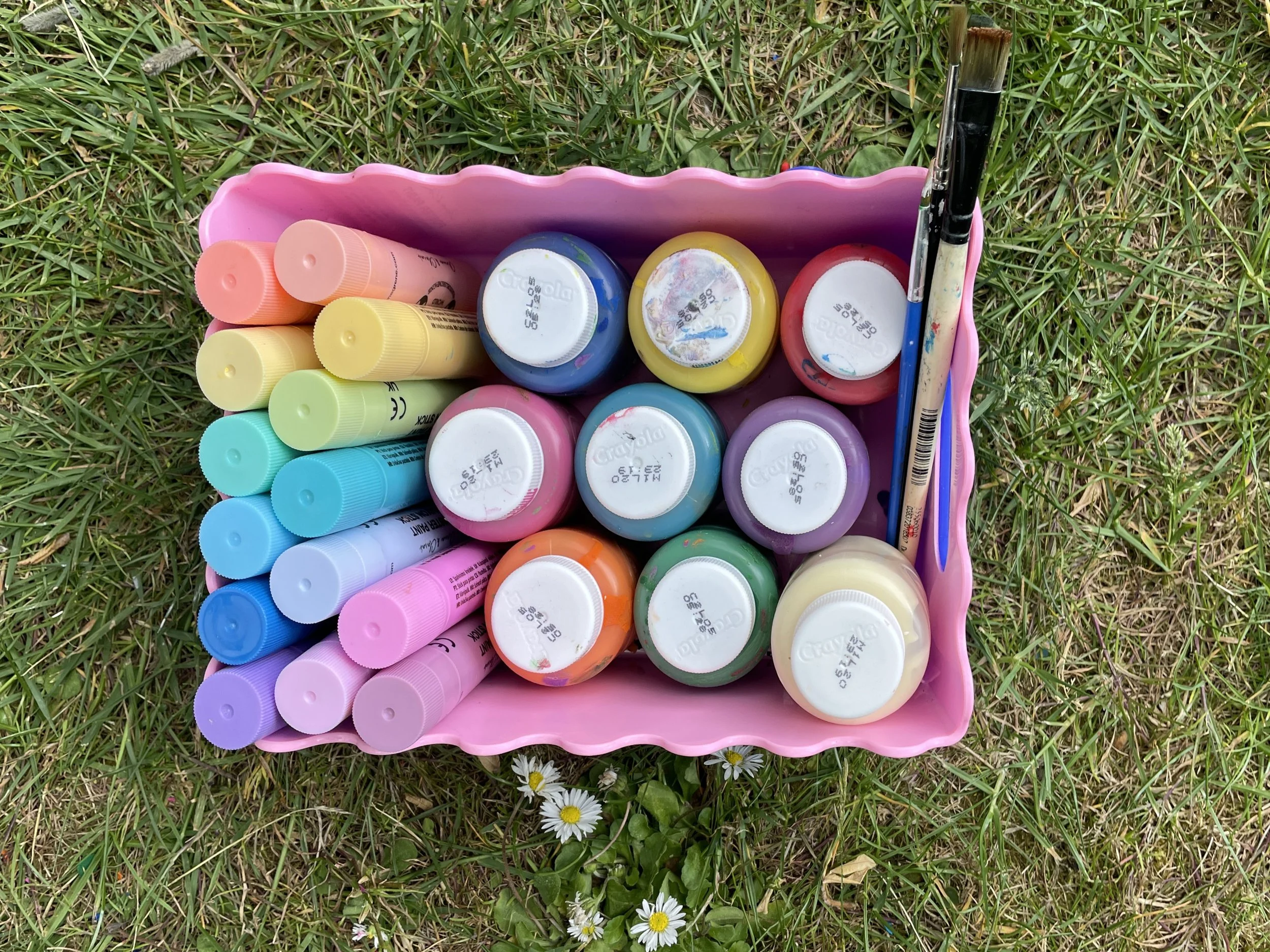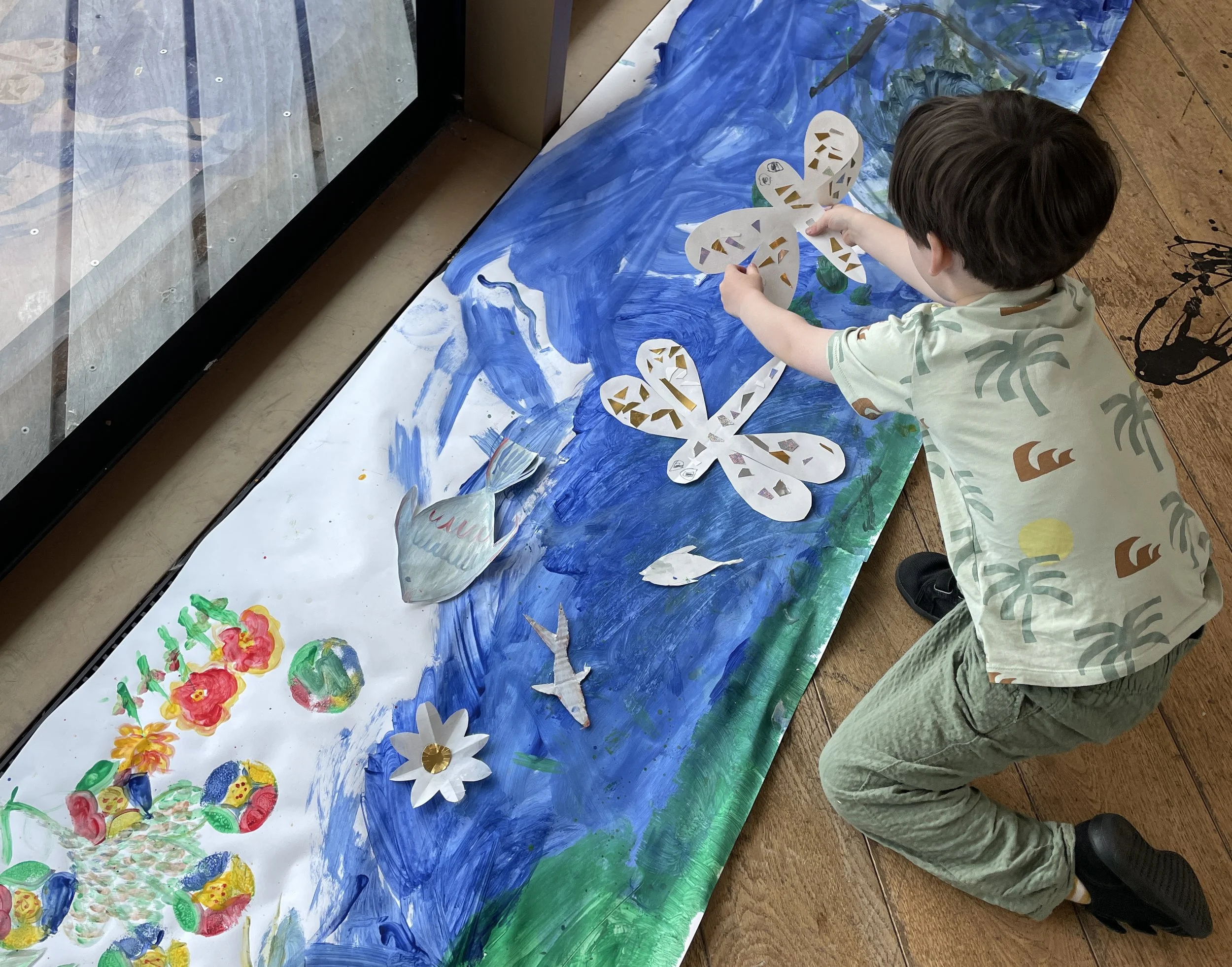Making Art with Pre-Schoolers
A little while ago I wrote a blog post on doing art with toddlers, which I know many people have found useful. It’s a few years later and I thought I would do an updated blog post on doing art with preschoolers, because it’s a whole different ball game! For toddlers art is mostly about exploration, whereas preschoolers often have a specific goal in mind and they’ll be trying to make or draw something in particular. This is where can things can get really fun and creative! Here are my top tips for making creativity part of your everyday family life, and nurturing your child’s sense of creativity.
Invest in good materials
Of course kids can create art with anything, but investing in some fun, developmentally appropriate materials is going to make things so much easier. Personally, I absolutely love paint sticks for this age group. They are so richly pigmented and they just slide onto the paper so easily. Imagine drawing with a lipstick, that’s the kind of texture they have. They are nice and chunky to hold and you don’t need to apply any pressure when you use them, so they’re really easy to use for little ones. They also dry to a waterproof and smudge proof finish, so they’re brilliant for craft projects as well as art projects. We use them for everything from drawing to decorating plant pots and painting stones. Also, they are a lot less messy than poster paint. We’ve got a nice selection now, and we bought them from Tiger, The Works and Aldi.
I also love the woody pencils for this age, again they are nice and chunky to hold and richly pigmented, they offer a little bit more control than the paint sticks and they work on lots of different surfaces. These wipe clean, so you can even use them to draw on windows.
One of our favourite craft materials to use is air dry clay. We have both the traditional air dry clay from Das, and a new kind of coloured light foamy air dry clay. I’m not sure what it’s officially called, but they sell it in The Works. We have made so much stuff out of this clay, it’s really soft and light, which is easy for little hands to work with, and it’s already coloured, so you don’t need to worry about painting it. The key things all these materials have in common is they are easy for a young child to use independently, and they are fun and colourful.
Make your materials accessible
Make sure your child knows what art materials you have and where they are. We used to have a little IKEA craft table in the corner of our living room, but we quickly outgrew it, and we’ve now moved all my son’s art supplies to our coffee table. It’s one of those coffee tables with storage inside and a lift up lid. It’s ideal because there’s loads of storage room inside, we can work on the coffee table, and then when we’re done everything can be hidden away inside again. It’s full of pompoms, pipe cleans, google eyes, air-dry clay, lollypop sticks and tissue paper. The coffee table is the perfect height for my son to stand and work at, and I can sit on the sofa and actually have a cup of tea whilst he’s making things. Turning your coffee table into a craft table probably isn’t for everybody, but it really works for us as it literally puts creativity at the very heart of our home. Growing up I always had a making cupboard, which was a cupboard full of making things that I had access to. I think for kids, knowing where the craft materials are and being able to access them is really important for empowering their creativity. If you want your kids to be creative regularly make sure their materials are accessible.
Go seasonal
I love coming up with the quick and easy seasonal arts and crafts projects to do with my son. It’s a great source of new ideas and helps us get excited about the change in the seasons. These don’t have to be complicated at all, Instagram and Pinterest is full of great ideas, the main thing is to let your child get creative with it and make it their own, don’t compare your creation to the original picture. I love keeping this simple and open ended. Why not try giving your child plain baubles and some watercolours to make Christmas decorations, or some air-dry clay and some twigs to make pumpkin from, or use cookie cutters, air dry clay to make easter decorations.
Know when to step back
One of the most important about doing art with this age group is knowing when to step back. They have their own ideas but they often still need our help. I have to make sure that I am acting as a facilitator, helping my son to realise his ideas, rather than trying to do it all for him, or offering him too many of my own ideas. This can be hard when you’re a creative person and you’re just brimming with ideas all the time! But it’s so important to step back and hear their ideas first, they might be approaching the project in a completely different way to you! Children are such original thinkers, which is one of the joys of creating art with them. So definitely help when they need help, and when they ask for it, but try to step back and let them do things their way, because for me the most important thing is my son learning to trust his own creative instincts, rather than having a perfect looking finished piece.
Try to say yes
This is one of the big ways that I try encourage my son’s creativity. When he comes up with an idea, I always try to say yes if it’s possible. We accidentally broke a plate and he wanted to turn it into a mosaic, so we looked up how to do that. He brought some twigs home from nursery and wanted to turn them into a mini campfire for his toys, so I got out the glue gun and we did it. I love hearing my son’s ideas, and what he comes up with. Sometimes they just aren’t possible, but most of the time they are and I love working on a little project together. As an artist the process of coming up with an idea - making the thing - problem-solving and pushing through - ending up with a finished piece is such an vital process, and I try to emphasise that process with my son. So I say yes to his ideas, and when we hit a snag I model how to problem solve, think creatively and keep going. These are skills I use all the time in my work, and I want to show him that it’s really normal as an artist to have to do things a few different ways before you find something that works. It doesn’t mean you’ve failed or that you’re not good at making, it’s just a completely normal step in the process. At around this age kids start to have a concept of things being right or wrong, their drawing being good or not, things looking how they’re supposed to, and by emphasising the power of ideas and problem-solving, I hope I can mitigate my son’s perfectionism a little bit
Follow their interests
As a professional illustrator, my medium is painting. Does my son love painting? Not particularly. He doesn’t mind it, but he’d rather be making something out of air dry clay, or using pipe cleaners and pom-poms. Right now he’s more interesting things that are 3-D than 2-D, so I go with that. Whatever your kids are into creatively, try to nurture that.
Take it outside
If you’re worried about mess or you don’t feel like you’ve got the space to create inside, creating outside can be a lovely experience. My son and I often do a bit of painting in the garden in the summer. This can also be a great technique if you want to get away from other distractions, like screens. I also love making nature part of our art, we’ve bought cyantype paper to make sun prints in the garden, and collected flowers to press and use in collages. I also recommend looking for art actives for kids at local museums and galleries, they are such a great way to encourage creativity and a different environment can be really engaging.
I’ve been following this method with my son for a little while, and now at almost 5 he sends me out the room when he’s really engrossed in an art project, so that he can work independently without distractions. He tells me don’t come in until I’m finished! He’s always so proud to show me what he’s done, and I’m not going to lie, I love the free time to have a cup of tea uninterrupted. We still create together a lot, but he now has the confidence to realise his own ideas from start to finish.
My favourite materials for 3-5 year olds:





